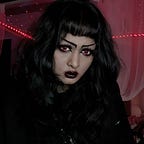The Evolution of the Goth Subculture
This dark, raving, underground counterculture that defined the 80’s after the punk movement is often associated with big hair, excessive makeup, vampires and where shades of black are the only acceptable form of colour, diminishing it to purely a fashion-based genre does the subculture a disservice. Key influences apart from the dark synth music we know of today are aspects like literature, architecture and philosophy that shaped the subculture way before it was recognized in modern-day society. The word “goth” was initially identified in late 300 AD and early 400 AD. The Visigoths and Ostrogoths were nomadic German tribes that fought against Roman rule, controlled Europe, and eventually took over and ran the nation for centuries.
With the fall of the Romans and the influence of the goths, Between the 12th and 16th centuries in France, a new, intricate style of architecture bloomed. Towering, complex designs, stained glasses, flying buttresses and pointed arches, Gothic architecture took over Europe during the middle ages. Churches were adorned in this style specifically to allow more light into the area. It was associated with royalty and the divine and is known as the “Gothic era of Europe.”
The 18th Century was the birth of a strange phenomenon known as the “Great New England vampire panic”. Nearly two centuries after the infamous Salem witch trials, people were convinced their neighbours were coming back from the dead to haunt and drain them of their blood. Known as “The Consumption”, it was a disease and the tuberculosis outbreak that caused an irrational fear of the Undead. People accused of being vampires were put to rest with a wooden stake run through their hearts, and some were even beheaded. Mercy Brown, one of the more notable cases, was said to have been infected with the “Consumption” after her family and their neighbours accused them of being vampires. Once they exhumed her body, it showed little decomposition, with “fresh” blood in her heart. Her heart was then burned, mixed with water and force-fed to her brother as a “tonic” against the consumption or, as they knew it, Vampirism.
The birth of this panic and the evolution of an undead creature that desecrates graves and drinks human blood sparked the interest of one Mr Bram Stoker in the late 18th Century. He wrote the legendary “Dracula”, which followed a dark shadowy figure modelled after the infamous Vlad the Impaler or Vlad Dracula, a ruler and national hero of Romania. Stoker’s development of a vampire character proved to be an essential aspect of Gothic literature. Almost all movies and TV shows written today are of the same calibre and are romanticized versions of the same character. Other authors like H.P Lovecraft and Edgar Allan Poe are also essential mentions in gothic literature.
With the invention of cinema, popular movies like Stephen Sayadian’s Dr Caligari and F.W Murnau’s Nosferatu shaped modern goth aesthetics. Films infused with horror, the supernatural and nightmarish elements complement the contemporary issues also highlighted in these films. The main components of these films may include a haunted location, damsels in distress, mystery and suspense, skies cloaked with dark clouds, nightmarish ghouls and lots of melodrama.
The 1980s was when the goth subculture as we know it today was born. It was mainly a music and fashion-based genre that revelled in dark, sexual aesthetics. The record that is credited with the invention of the goth genre is Bauhaus’ Bela Lugosi’s Dead which was released in August of 1979. This 9-minute track incorporated chilling, clangorous, dub-infused sounds accompanied by Peter Murphy’s rich, deep-toned vocals and sombre lyrics that drew inspiration from the movie Dracula (1931) and its leading cast member, Bela Lugosi. Dubbed “Gothick Romantick pseudo decadence” by the NME, Bauhaus’ In the flat field also topped the UK charts in the late 1980s. Over the next year, Siouxsie and the Banshees released JuJu, The Birthday Party with their hit single Release the Bats, and other significant influences like Alien Sex Fiend, Sisters of Mercy and the American deathrock band Christian death.
Goth went “mainstream” in 1982 after The Cure were seen sporting red lipstick, big hair and dark eye makeup following their Pornography album. Goth found itself not only overground but in a more active lifestyle with the infamous Batcave clubs established in 1982. The nightclub scene featured up-and-coming goth artists, raves and DJ nights that thrived on inclusivity and pushing societal norms. Queer culture and the Drag scene were also key influences in the Evolution of Goth.
In the present landscape, with the availability and accessibility of music, movies and literature, Goth has become a worldwide phenomenon. People from all corners of the world, races, genders and religions find themselves drawn to this dark, mysterious counterculture that not only continues to evolve but has found a permanent home with Generation Z and their need to stand out and speak out. Connecting millions of users over social media and gaining an online community of like-minded people who enjoy and share similar interests.
